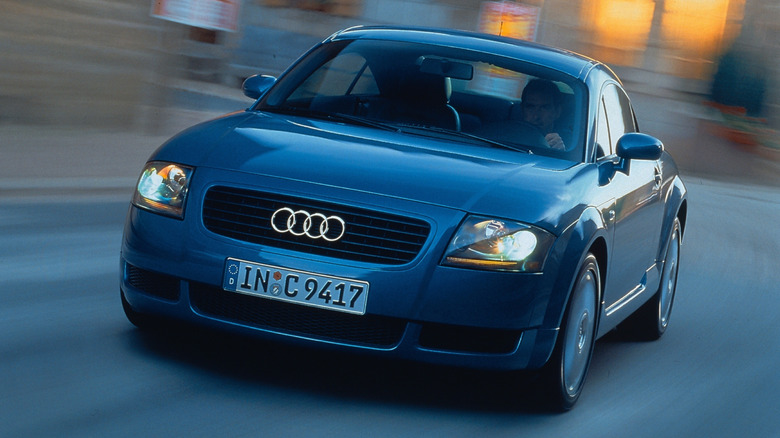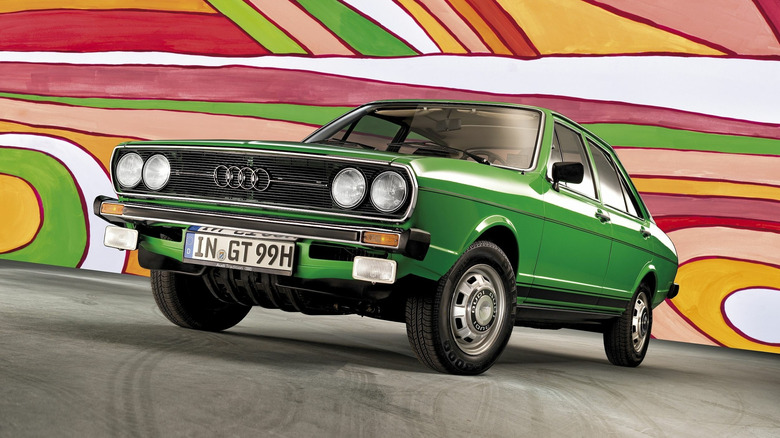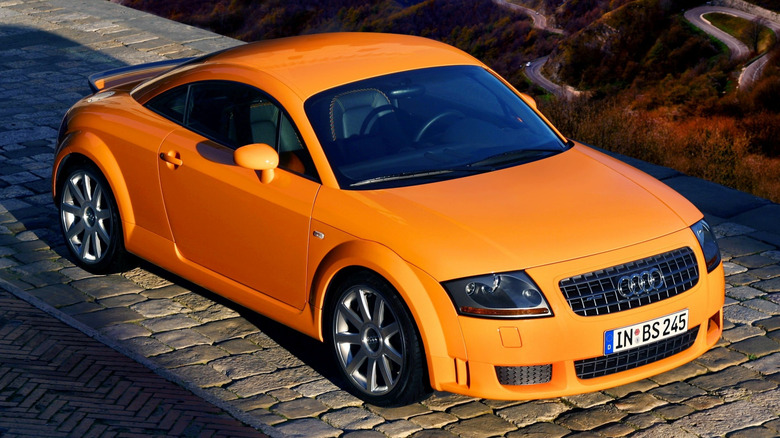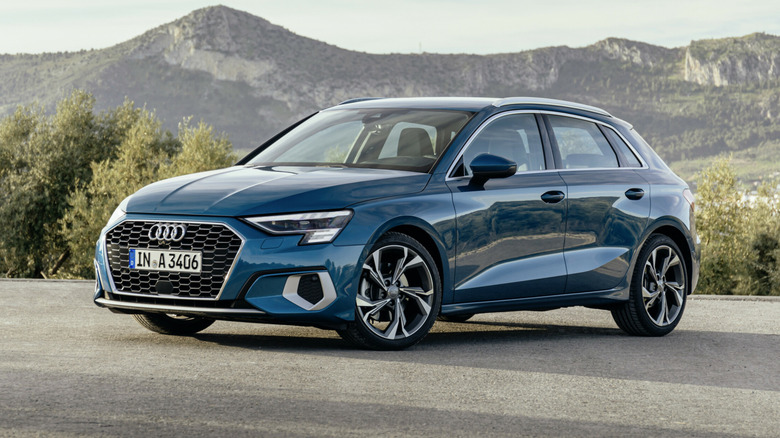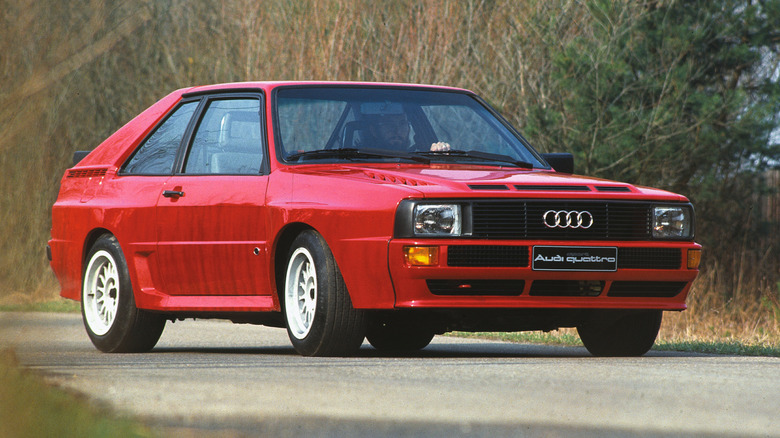10 Of The Most Successful Models In Audi History
The modern Audi brand was born in the mid-'60s as a division of Volkswagen, although it nearly didn't turn out that way. Evolving from the struggling Auto Union, the brand became a success against the odds, thanks to the ingenuity of its cars. Those cars were at times developed in secret, and with limited funding, but their success proved instrumental in turning the brand into the major industry player it is today.
There are lots of ways to define what success means in the automotive world — it can mean strong sales figures, a positive critical reception, a dedicated fanbase, or being influential on later models. Often, it's a mix of all of them. Each of the 10 models we're highlighting here have proved to be particularly important in Audi's history, with most also boasting high sales figures and critical praise to complement that historical importance. That combination makes them arguably among the most successful Audi models to date.
Audi Q7 (2006 to present)
The Q7 was Audi's first production SUV, launching in 2005 amid what was then still an emerging market for luxury road-oriented SUVs. Audi was relatively late to the party among German manufacturers — the BMW X5, Mercedes-Benz M-Class, and Porsche Cayenne all beat it to market by several years — but the Q7 proved successful nonetheless. Much like its rivals, the Q7's appeal centered around its road manners, interior space, and luxurious materials, a formula that still remains unchanged today.
The latest iteration of the Audi Q7 was unveiled for the 2025 model year, boasting upgrades to both its infotainment tech and its powertrains. Alongside the Q7, a sportier SQ7 variant is also available with around 500 hp on tap. It might not be the biggest selling SUV in Audi's lineup by volume, but the Q7 continues to play a key role alongside the Q8 as the joint flagship model in the brand's SUV range. Its expanded lineup of smaller SUVs offer a more affordable alternative into Audi ownership, but they may never have been developed had the original Q7 not proved such a success for the brand.
Audi R8 (2007-2024)
As well as being arguably one of Audi's best looking cars ever, the R8 was also one its most ambitious. The brand's first true supercar shared both its platform and powertrain with the Lambroghini Gallardo at launch, becoming Audi's halo model and something of an experiment for the brand. Audi had plenty of racing history — in fact, the R8's name was taken from the brand's record-breaking Le Mans prototype — but had never channeled that expertise into a road car quite like this before.
The resulting car was a success in several ways, with its competition variant being highly successful on track and the road variant proving that Audi could produce a supercar to hang with the big guns. The German automaker didn't rest on its laurels either, continually tweaking the R8 over its time on sale with new and improved versions of both its coupe and spyder models.
However, its sales were never as strong as Audi bosses had hoped for, and the R8 was criticized by some for being left behind by its rapidly evolving rivals, despite Audi's periodic upgrades. Perhaps not the most successful supercar of its era then, but definitely a big success in terms of elevating the image of the Audi brand and giving its scores of sedan and SUV buyers a highly desirable — if largely unattainable — halo product to aspire to.
Audi 80 (1972-1995)
Forming the backbone of Audi's lineup during its decades on sale, the Audi 80 got an unexpected boost later in its production run when Britain's Princess Diana bought one. At the time, the intense press coverage of her life gave Audi a huge amount of free publicity, and sales skyrocketed. However, the 80 deserves more than to be remembered as simply the Princess' car of choice.
The B-Series 80 was first launched in 1972 and won widespread praise for its handling and efficiency. It was more compact than other sedans at the time, but didn't compromise on power or technology. Buyers snapped up more than a million examples in just six years, and continued to keep demand high over the car's four generations. Audi originally intended production to take place solely at its Ingolstadt factory, but with so many buyers placing orders, two VW plants were also roped in to keep wait lists from overflowing. Eventually, the 80 nameplate was retired and replaced with the equally successful A4.
Audi TT (1998-2023)
Audi's small sports car was both a critical and sales success at its launch, with the first generation car selling over 178,000 units between 1998 and 2006. The TT managed to establish itself as a thoroughly fashionable car, and thus became popular with image-conscious buyers looking for a sporty daily driver. It wasn't quite as hardcore as other rivals from the era, and so its appeal among traditional enthusiasts was more limited. This was, after all, a sports car with an engine and platform borrowed from the humble Volkswagen Golf.
However, those enthusiasts would be better served by the hotter versions Audi would release later in the TT's lifespan, including the TTS and TT RS. Both variants were launched during the car's second generation, which remained in production until 2014. The final generation of the car was retired in 2023 amid slowing sales, with the hype of the original long gone. Its spark might have fizzled out a little toward the end, but the TT's early years secured its spot among the brand's most successful cars to date.
Audi Q5 (2008 to present)
Launched only two years after the Q7, the Q5 has proven to be Audi's best selling SUV model, with around 1.6 million examples sold over its first eight years on sale. It was essentially conceived as an SUV version of the A4, and shared the latter's platform and powertrains. Much like the Q7, on-road performance was given first priority — Audi knew all too well that the closest that the vast majority of its buyers would get to off-roading was clipping the curb on the way out of a mall parking lot.
The latest iteration of the Q5 retains the same basic formula, and it still shares its platform with Audi's family sedan (although, confusingly, that sedan is now referred to as the A5 rather than the A4). It is now in its third generation, with many of the biggest changes arriving in the form of new infotainment and safety tech. It remains a strong seller, particularly in Europe and in its home market of Germany, despite the increased competition in the segment. With the new generation now in dealerships, there's no reason to think that the latest version will be any less successful than its predecessors.
Audi A3 (1996 to present)
When the Audi A3 debuted in 1996, there wasn't anything else quite like it on the market. Taking the premium interior and driving dynamics best associated with the brand's sedans and combining it with the bones of the popular VW Golf, the A3 was the first player in what's now known as the premium hatchback segment. Mercedes-Benz would try a similar formula — with slightly less success — with the A-Class a few years later, while BMW offered the 3 Series Compact and later the 1 Series.
None of its German rivals have managed to eclipse the popularity of this Audi model, which had sold more than five million units by 2020. It remains a hit across Europe, particularly in the U.K., where it ranks in the top 10 best selling models overall according to 2024 sales data. The hatchback continues to be related to the Golf, but like the brand's other models, it has undergone a series of styling, powertrain, and technology changes throughout the generations to keep it competitive against its ever-changing rivals.
Audi Quattro (1980-1991)
The original model to wear the iconic Quattro badge was introduced in 1980, and would remain in production until 1991. This wasn't originally Audi's intention — the plan was to produce just 400 examples to ensure that Audi could homologate the car for racing, but with buyers snapping up that original allotment, the brand decided to make a few more. And then, a few more after that. It kept churning them out until eventually 11,452 examples had been produced.
As well as being a legendary road car in its own right, the Quattro is arguably the most iconic rally car of all time. The car popularized the use of all-wheel drive and took several major titles including both the manufacturers' and drivers' WRC crown in 1984. It proved successful in hill climb racing too, winning at Pikes Peak in 1987.
Today, the Quattro system remains a key part of the brand's appeal, and can be found across its lineup. According to Audi, almost half of its entire inventory sold in 2019 featured the Quattro system. A resounding success then, and one that might never have been were it not for the achievements of the '80s classic.
Audi 100 (1968-1976)
Although later models would wear the 100 badge, the original generation has remained the most critical in ensuring the brand's future success. It was first launched in 1968, having been developed in secret by Audi's chief engineer. At the time, Audi was still in turmoil — a few years earlier, its predecessor Auto Union had been bought by Volkswagen, mainly for its factories and production staff. Volkswagen didn't intend on allowing Auto Union to develop its own cars, but its chief engineer did just that regardless.
Eventually, the secret was unveiled, but the resulting car impressed VW bosses enough that they allowed production to go ahead. It was christened the 100 and immediately caught the attention of both the press and public at launch. In a twist of irony, the Audi proved so popular that its main factory couldn't keep up with demand, and Volkswagen ended up enlisting two of its own factories to assist with production. A grand total of 827,474 examples of the first generation 100 would eventually be produced, with its popularity paving the way for future Audi models to be developed.
Audi A4 (1994-2025)
First launched in 1994, the Audi A4 had the tough task of living up to the success of its predecessor, the 80. It did so with aplomb, offering an improved ride, revised powertrains, and extra interior space. Keeping its German rivals at bay — namely those from BMW and Mercedes-Benz — was no easy task. Their ever-changing nature meant that the A4 also continuously evolved, with the B5 giving way to the B6 in 2001 and the B7 arriving in 2004. The B8 was launched for 2008, and then it took until 2015 for the B9 to hit dealerships.
Across each one, Audi continuously tweaked the A4's design, although never radically so. It simply didn't need to, as it continued to be the brand's best selling sedan year upon year. However, the impending integration of electrified models into the brand's main A-Series lineup necessitates that A4 undertakes its biggest change yet. At least, its biggest change in naming terms.
The A4 nameplate will be used for an electric car from 2025, while the gas-powered A4 will become the A5. There is, of course, already an Audi A5 in the lineup, which is a two-door variant of the A4. The new 2025 models will be merged, marking the end of the traditional gas-powered A4 model, even if the nameplate lives on in a different form.
Audi RS2 Avant (1994-1995)
While it boasts the shortest production run of any of the successful models here, there's no denying the impact that the RS2 Avant had on Audi's history. It was the first car to wear the RS badge, and was developed in conjunction with Porsche. Notably, it also borrows some of its parts from Porsche's parts bin. Its success paved the way for the RS range of today, despite it being one of the models Audi never offered in America.
Audi had initially planned a run of 2,200 examples of the RS2 Avant, but after seeing the original allocation get quickly snapped up by enthusiasts, the brand expanded production by a further 700 units. It was only ever intended to be a niche vehicle — a kind of experiment by Audi execs to see how well a fast wagon would perform in dealerships — but its success spawned the RS4 Avant and RS6 Avant, alongside other RS-badged models to expand on the original car's go-fast philosophy.
